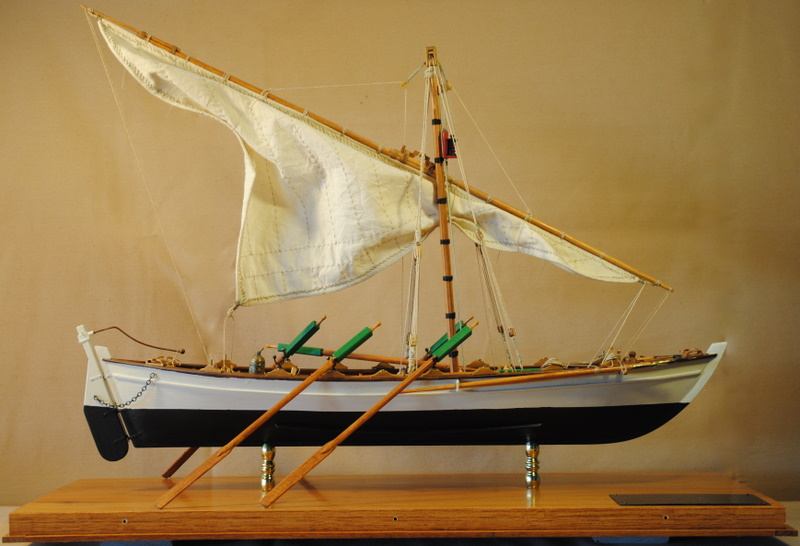Whale Boat
Particulars
Vessel type: Whale boat
Designer: Evolving design with relatively minor regional differences
Builder: Various in Europe and the Americas
Keel Laid: Second half of 19th century
Date Delivered: Construction time was generally around six months
Date Modified: None, whale boats were occasionally used for raiding expeditions
Date Scrapped: Typically a whale boat lasted for only a few seasons of use
Length on deck: About 28 feet
Length over all: About 30 feet
Beam: About 6.8 feet
Depth: About 4.2 feet
Draft: About 2.8 feet with rudder hooked on the stern
Construction Material: Wood, carvel planked on frame
Rig Type: Lateen
Sail area: About 250 square feet
Crew Size: Seven, five rowers, one harpooner and a boatcaptain
Propulsion: Oars and sail
Cruising Speed: 6 Knots
Maximum Speed: As much as 12 knots when towed by a whale
Armament: Various harpoons and lances for hunting whales
Vessel Description and History
Whaleboats like this started to be built in the early 1800’s and continued to be built until the end of that century. They were the primary means for hunting whales of all kinds. A typical whale boat would be about 30 feet long and be manned by six crew members: four rowers, a boat captain who steered the boat, and a harpooner. The boats were supplied with harpoons, tubs of rope, a killing spear, a sailing rig, navigation gear and food and drink for a few days. With the crew rowing hard, the boat could achieve a speed of about 6 knots, not quite enough to keep up with a whale.
These boats could be shore launched, but once coastal whaling grounds were depleted, they were carried on whaling ships operating as motherships to several whaleboats. The mothership would sail out to promising whaling grounds and, when whales were sighted, the boats would be launched to hunt. Whale boats would quietly row or sail up to sleeping whales, or hope to position itself near a surfacing whale, allowing the harpooner in the bow to strike the whale. A harpoon was designed to penetrate the skin of the whale and anchor itself beneath the skin. This would make the whale try to escape but the rope attached to the harpoon would keep the whale boat connected to the whale. The whale would try to dive or swim away and the whaleboat would work to maintain its connection to the whale. If the whale tried to escape, it may tow the whaleboat, pulling it as fast as 12 knots, sometimes even more.
Once the whale was exhausted, the boat captain would take the bow and kill the whale with the killing lance.
Since the whales were generally larger than the whaleboat itself, they were very dangerous prey and could easily smash the whaleboat and kill the crew. Once the whale was dead, the crew had to tow the whale to the mothership. This was a back breaking task, aided a little by the sail if the wind blew from the right direction.
Technical Model Description
Model Scale: 1:16
This model was built from a kit produced by Panart SRL in 1981 and built in 2000. This model is of a scale where every component that exists on the full size hulls is also constructed on the model. As such, all structural components shown on the model also exist on the full size vessels. The construction made use of builder’s frames used to shape the hull frames and fitted hull planks similar to builder’s frames used for the construction of the full size vessel. The 1:16 scale is about as small as can be used to build actual structural models. If one uses a smaller scale it becomes very difficult to construct smaller structural components and fit them into the model, so the model builder will have to alter or simplify the model construction from the full scale vessel.


